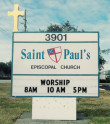The King of Kings and Lord of Lords
Texts: Acts 1:1-11, Psalm 110, Ephesians 1:15-23, Luke 24:44-53

Sunday Sermon
The Rev. Dr. D. William Faupel
Priest-in-Charge
May. 28, 2017
Introduction
Last Thursday most churches, including St. Paul’s, were empty. It was a silent Thursday. Although it is designated a “Principal Holy Day” in our church calendar, the Feast of the Ascension has become, in practice, the Cinderella festivals of the church. It slips by all too quietly, and with little due regard to its importance for the ongoing work of Christ for our lives today.
We do wrong to minimize it, however, for it rates a full line in both the Apostles and the Nicene Creeds. In a few minutes, we will again affirm as we do each Sunday: “He ascended into heaven and is seated at the right hand of the Father. It is important that we give this day a second look and make it a day to remember.
I
The biblical story places the Ascension forty days after the Resurrection, which means that it always falls on a Thursday. Only St. Luke speaks of the Ascension, first in the closing words of today’s Gospel and then in the opening lines of the Acts of the Apostles, which is also from his pen. It is Luke who gives us the forty-day figure, reminding us of Jesus’ forty days of temptation. His ministry opens and closes with a forty-day period.
This number is both significant and symbolic to the biblical writers. Moses spent forty days on the Mountain of Revelation when he received the ten commandments. Israel spent forty years wandering in the wilderness. I invite us to think of our Lord’s own forty-days as periods of revelation. At the beginning of His ministry, God the Father discloses the divine will for Jesus and the nature that His ministry will take. The temptations were inducements to seize for Himself a different kind of ministry than that which the Father disclosed. At the end of His ministry, Jesus is Himself the Revealer, showing Himself alive to His disciples, and disclosing God’s will for them and the nature of their life as the church.
At the end of forty days on the mountain, Moses descended to continue leading God’s people from Egypt to the Promised Land. At the end of the forty days of temptation, Jesus left the desert to call His disciples and begin His ministry. But now, forty days beyond the resurrection, His work is completed and He withdraws from the disciples and goes to the Father.
The forty-day figure suggests that other language in the story may be symbolic as well. With what we now know of outer space, we would be wasting our time trying to figure out where Jesus went when he ascended. St. Luke’s language in the Gospel is reserved: “He withdrew from them, and was carried up into heaven.” In the Acts of the Apostles, he adds, “a cloud took Him out of their sight.” For Luke, the cloud was significant because it ties the Ascension to the book of Daniel where “the Son of Man” comes to God “with the clouds of Heaven.”
Where did Jesus go? In the language of John’s Gospel which we hear read two weeks ago, He went to the Father to prepare a place for us.
II
Preparation of our final home is not the only job description that we have of the present work of Christ. The Epistles frequently refer to Him as now seated at God’s right hand, where He rules both the church and the world. St. Paul’s language in today’s New Testament reading is typical. “God …set Him at His right hand in the heavenly places far above all rule and authority and power and dominion…and…He has put all thing under His feet and made Him the head over all things for the church….”
This passage is an allusion to Psalm 110 where God says to the king “Sit at my right hand until I make your enemies your footstool.” (This Psalm, by the way, is quoted more frequently in the New Testament than any other passage of the Bible).
The real importance of the Ascension, then, is that it marks both the end of our Lord’s mission to earth and the beginning of His heavenly rule. We understand the work of Christ to be that of Prophet, Priest and King. During His life on earth He functioned as Prophet, in His death He was our great High Priest. Now he reigns as King in heavenly places.
Thus, above all, the Ascension speaks to us about our Lord’s kingship. He ascended to the Father and now sits at God’s right hand. Jesus sits. This is a word we still use of authoritative rule and decision. When Congress is seated following each two-year election, the government is in session. Jesus sits. Today’s epistle spells this out in two broad ways. One is related to civil authority:
“God has seated Christ far above all rule and authority and power and dominion.” This is Christ’s rule of power. The second is related to the Church: “God has made Christ head over all things for the Church, which is His body.” This is Christ’s rule of grace.
III
The Ascension is important because it has enabled our Lord to sit over all human government. This is something that both the Catholic and Reformation traditions took very seriously. From the time of Constantine this was recognized by almost all governments in the western world. This understanding only collapsed in our secular age and is now seldom asserted.
Thus, many Christians today would hesitate to make this assertion. It is easy to understand why. Our own political order is so fallible, so disorderly, and Christ’s rule so remote, so invisible, that it seems foolish even to talk about it in this way.
When we look at what we have experienced coming out of Washington DC for the last twenty years or so and probably think “very far above indeed” at is where God has seated Christ. So far above that our government is probably out of sight to Him, and certainly He to them.”
How seriously can we take our Lord’s rule of power? I believe here are at least two things we can say. First, with St. Paul, we can say that our Lord values civil government and uses it in pursuit of God’s immediate goals for human life in society. He delegates to civil government certain functions, such as administering justice and formulating laws that serve the wellbeing of all its citizens.
This does not mean that we should identify the church with the state or with a political party. The church must keep its independence so that it may be free to offer a prophetic critique of the state’s actions and polices. But it does mean that we believe that Christ is at work in and through the actions of the civil state, to accomplish the divine goals.
Secondly, beyond our immediate well-being, there are also God’s long-range goals, taking back a world gone wrong, and of establishing His Kingdom here on earth. God will use the state; He will work around the state, and eventually, we believe, He will bring down those that are corrupt, oppressive, and abusive.
It is a statement of faith. Sometimes that faith becomes sight, as on V-E Day, or with the fall of the Berlin wall or when the United States granted civil rights to all its citizens. At other times, we may not always see the influence of Christ’s power and authority in many actions of our governments, but we believe that the risen Lord is present and at work, however much the greed, foolishness, or evil within people obstructs Him for the moment. That is our faith and we confess it.
IV
I believe it is much easier for us to confess his rule of grace, as head of the church. Each Sunday as we gather to worship, we feel his gracious presence among us. In our weakness, we experience his strength. In our ignorance, we find his wisdom. Each of us, if given the opportunity, could recite countless times when his rule of grace has been made known to us.
So today, we acknowledge our Lord in his present work, as ruler of the universe and head of the church. Amen
SUPPORT ST. PAUL'S DONATE NOW OR RECURRING DONATION

3901 Davis Blvd., Naples, Florida 34104 239-643-0197 Office hours 9 a.m. to 1 p.m. Monday-Friday


